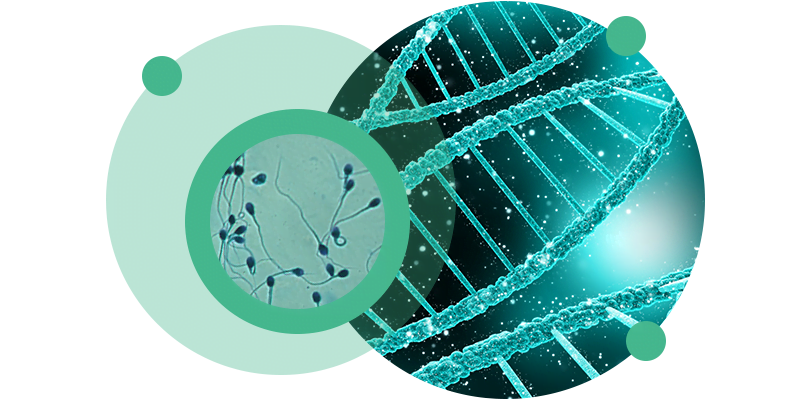DNA Fragmentation
Changes in the structure and functionality of spermatozoa can lead to a lower pregnancy rate. The integrity of sperm DNA is one of the fundamental factors in fertility, as it contributes to the genetic factors that affect the proper development of embryogenesis. In the absence of this integrity, i.e. in the presence of DNA fragmentation, this process is altered, with DNA fragmentation being significantly higher in infertile men.
It is therefore becoming clear that more complex tests than the spermogram are needed in everyday clinical practice, particularly in men belonging to couples with recurrent miscarriages due to natural conception or medically-assisted procreation, and in men suffering from unexplained male infertility.
Although definitive conclusions cannot be drawn, given the heterogeneity of the studies, in many of these men there is evidence that sperm DNA may be damaged, leading to miscarriage.

About DNA Fragmentation
Changes in the structure and functionality of spermatozoa can lead to a lower pregnancy rate. The integrity of sperm DNA is one of the fundamental factors in fertility, as it contributes to the genetic factors that affect the proper development of embryogenesis.
DNA fragmentation is due to enzymatic defects that disrupt the normal structure of DNA. Similarly, changes in the programmed cell death mechanisms, which are fundamental to the elimination of abnormal cells, can lead to the presence of a greater number of spermatozoa with DNA fragmentation.
However, and this is no less important, oxidative stress is currently the subject of a great deal of study because of its highly probable influence on the loss of DNA integrity. Knowing that the presence of low levels of oxygen free radicals is fundamental to the excellent functionality of spermatozoa, we now know that the presence of inflammatory phenomena in the testicles and/or epididymis is highly deleterious to DNA integrity, because it increases the production of these free radicals. radicals. In addition to inflammatory phenomena, other situations can increase oxidative stress, namely vitamin and growth factor deficiencies, as well as pathologies such as varicocele, obstructive lesions of the seminal tract and mutations in the cells of the epididymis.
Given that the spermogram is a descriptive assessment that can distinguish between sperm from fertile and infertile men, it is now also clear that sperm DNA damage can occur in infertile men. DNA fragmentation is a common occurrence in spermatozoa up to certain levels due to reproductive biology, but an exaggerated increase in this level of sperm DNA fragmentation has been shown to reduce the possibility of natural conception.
Although no study has unequivocally and directly tested the impact of sperm DNA fragmentation on the clinical assessment of infertile couples, sperm DNA fragmentation is more common in infertile men and has been identified as a major contributor to male infertility in the form of worse subsequent outcomes. These include changes in embryonic development, more miscarriages, an increase in recurrent miscarriages and a higher frequency of congenital anomalies.
Sperm DNA fragmentation can be increased by a number of factors. These include hormonal abnormalities, varicocele, chronic infections (particularly of the seminal tract) and lifestyle factors (e.g. smoking).
Several tests have been described for measuring sperm DNA fragmentation. It has been suggested that current methods of assessing sperm DNA integrity are not yet valid for predicting outcomes of assisted reproduction treatment and that there is controversy as to whether they should be routinely recommended for clinical use.
The most frequently used test, and currently the most validated, is the sperm chromatin structure assay (SCSA), which indirectly assesses DNA fragmentation. This test of sperm chromatin structure remains the most widely studied in this field. In SCSA, the number of spermatozoa showing DNA fragmentation is indicated by the DNA Fragmentation Index (DFI). It has been suggested that a DFI threshold of 25%, measured with SCSA, is associated with reduced pregnancy rates by natural conception or intrauterine insemination (IUI).
In addition, DFI values >50% in the SCSA are associated with worse in vitro fertilisation (IVF) outcomes. More recently, scores relating to the proportions of spermatozoa with high or low DNA fragmentation have proved useful for diagnosing male infertility and providing additional discriminatory information for predicting live births by IVF and ICSI.
Irrespective of DNA fragmentation rates at testicular level, which exist even under the best conditions, it is known that extra-testicular factors play a very important role in the deterioration of these rates. Infection and/or inflammation of the epididymis, seminal vesicles and prostate lead to an increase in oxygen free radicals.
In addition, radiotherapy and/or chemotherapy treatments can cause damage to the DNA chain, either temporarily or permanently, depending on the type, duration and intensity of the treatment.
The presence of varicocele, due to reduced oxygen concentrations, increased temperature and venous reflux of catabolites to the testis, also leads to increased levels of oxidative stress, suggesting more targeted therapeutic approaches.
The spermogram, which makes it possible to assess advanced seminal parameters in specific situations and according to very clear indications that vary from one man to another, namely the rate of DNA fragmentation of spermatozoa, has made it possible to use this parameter to guide therapeutic attitudes more effectively.
Testicular spermatozoa have lower levels of DNA fragmentation index (DFI) than ejaculated spermatozoa. Couples with high DNA fragmentation may benefit from a combination of testicular sperm extraction and intracytoplasmic sperm injection (ICSI), an approach known as TESE-ICSI. However, more evidence is needed to support this practice in the routine clinical setting.
In couples with a history of recurrent miscarriages with no defined cause and long-term idiopathic infertility, measurement of the fragmentation rate will be indicated, in order to be able to define more precisely which couples will benefit from a sperm sample taken directly from the testicle . The same applies to men with varicocele, who have very high DNA fragmentation levels in their sperm.
Improving this parameter after varicocele correction surgery could in fact allow natural conception or a substantial increase in the effectiveness of medically assisted procreation processes.
Common questions
Yes, but not arbitrarily. In situations defined by the Urologist/Andrologist, research into the sperm DNA fragmentation rate makes it possible to complete the male infertility assessment process, making it possible to improve the parameters for predicting the success of medically assisted procreation treatments, as well as those for natural procreation. design. in well-defined situations, i.e. when the analysis of classic spermogram parameters does not show any marked changes, and when pathological situations leading to an increase in oxidative stress are encountered.
You can consult the CETI price list here.
Not directly, since this test only assesses the fragmentation of genetic material. However, it is not the recommended test for assessing the possibility of transmitting genetic pathologies, as there are currently specific genetic tests for detecting various pathologies that can be passed on to offspring.
Although there is no absolute proof that age is an issue in the rate of DNA fragmentation, the truth is that as we age, levels of oxygen free radicals increase further and, consequently, the likelihood of this rate worsening.
Consequently, all attitudes that delay the development of oxidative stress via the reduction of oxygen free radicals are recommended, such as avoiding the consumption of drugs and alcohol, smoking, avoiding exposure to high heat sources, ionising radiation and certain chemicals. deleterious effect on sperm production.
